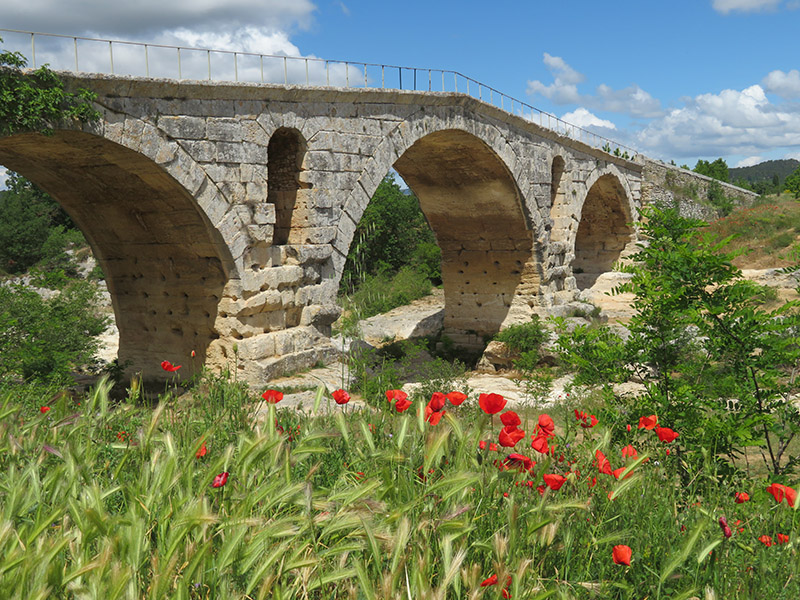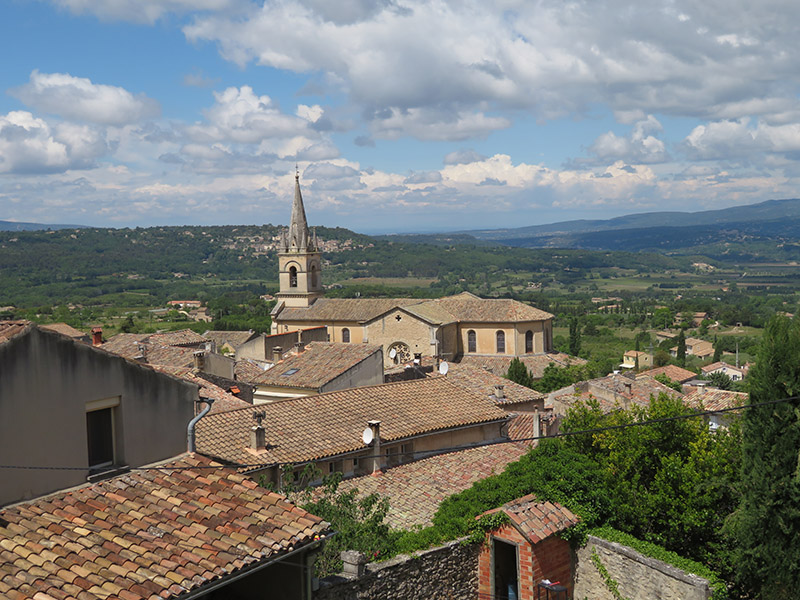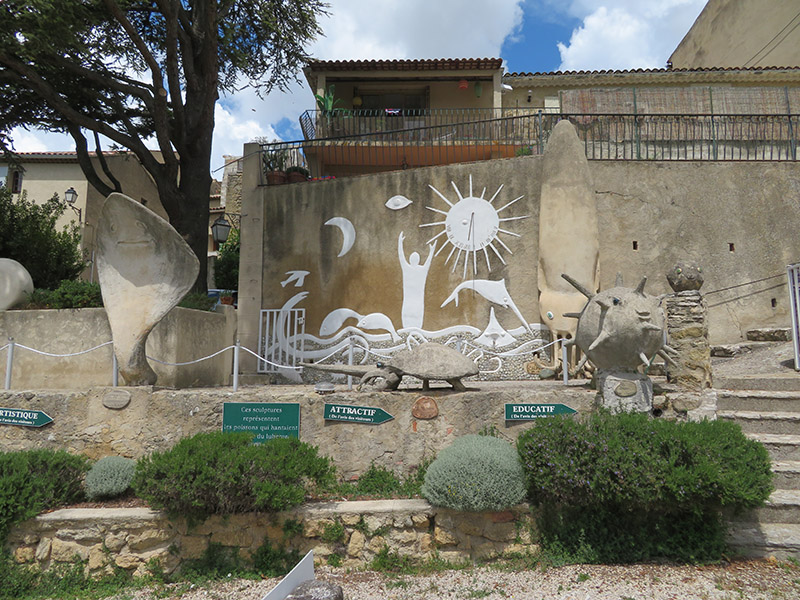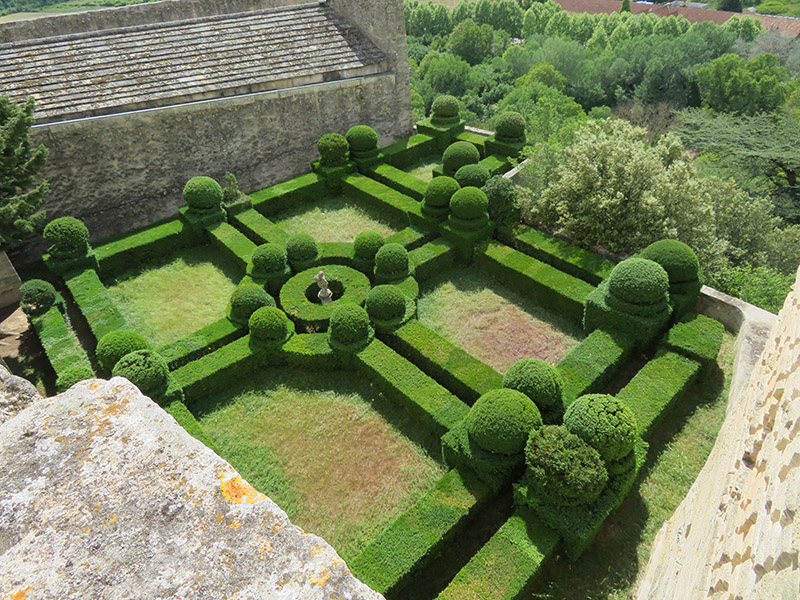WEEK 1 | WEEK 2 | WEEK 3
Week 3
Sunday morning, we headed out of town for the Petit Luberon area of Provence. There were two picturesque hilltop villages we wanted to see, Bonnieux and Ansouis. The area has craggy hills interspersed with wooded valleys, vineyards, and farms. First, we went six kilometers past Binnieux to see the Pont Julien, which is an ancient Roman bridge, dating to about 3 BCE. It is 85 meters (93 yards) long and was part of the Via Domitia, the longest Roman road in Europe. It has three high stone arches that cross over the Calavon River, which was flowing pretty low. The bridge was only recently closed in 2005 to traffic, an amazing testament to its strength and endurance.
Then back to Bonnieux, which was settled during the Roman era and still has preserved its medieval character. There wasn’t much to see, but the tiny town is picturesque with narrow curved hillside roads and old stone homes. The main street is so narrow that there is a signal at either end of town, which only permits traffic one way at a time on a single lane. We parked in a slightly lower lot from the top of the town and climbed up a few stairs to the main street. We opted for lunch at La Terrazza, an Italian café with great tables outside that over-looked the valley below with staggered levels of homes against the hillside.
Vere ordered a ham and mushroom pizza and I ordered the vegetarian lasagna. His pizza turned out to be pretty good, but my lasagna was terrible. First, it was layered not with pasta but with potatoes. The few other vegetables inside were minced so small, I could hardly discern them. The top had a toasted breading, no cheese, there was no tomato sauce, and it was tasteless. It came with a very bitter lettuce that was drenched in olive oil. I picked at both but ended up eating very little of either. If the dishes I keep getting are going to be this bad, I’m going to end up losing weight on this trip instead of gaining.
Back to the car and on to our next stop, to Ansouis. Ramparts, watchtowers, and gateways of stone still circle the village’s old center and medieval gateway. We wanted to see what our tour book touted as La Museum Extraordinaire. So many sites claim to be amazing, but for this one they were right. The front had large iron works of art and inside was incredible. We were met by a husband and wife team, and the wife spoke English, so she was the one who gave us the tour. Her father, Georges Mazoyen, in the early 1960s, was a world traveler and scuba diver. He dove in every area that he traveled and brought amazing things back. He was also a painter and ceramicist, and a small kiln is still in the house, which is still used.
The place was filled with not only his undersea paintings and ceramics of fish, but also shells, fossils, collectible stone samples, and hundreds of other oceanic items. Glass cases were filled with items from oceans around the world. At the end of one room, we entered a narrow walkthrough diorama of an undersea scape with blue lights, the whooshing of underwater sounds, real fans of large coral and amphora. Finally, we emerged into their workshop filled with blue painted ceramics; plates and bowls, small turtles and fish. Additionally, the daughter was selling a book that she had written all about her father’s adventures, with pictures of his works of art. We bought the book as the place was extraordinaire.
Then we had to leave, as at 3:00 we had a reservation for a tour of the Chateau d’Ansouis on top of the hill. We were only five minutes away on foot, but the way up was along a steep narrow walkway all the way to the castle. When the gates opened, a small crowd entered the front courtyard and gathered under some trees to listen to our hostess give us an introduction of the history of the building. The entire tour was said in French, but Vere translated important aspects to me in English, when I didn’t understand them.
This ended up being a two-hour tour, walking up and down through the palatial rooms. Unfortunately, we were not allowed to take pictures inside. The chateau was originally two large homes that the previous owners had connected into one large home. It was also at one time a fort and used as army barracks. The fort lay empty and dormant for about forty years before it was purchased by private owners, who did a lot of renovations to bring it into modern use. In 2008, the present owners found the place completely empty, so they filled it with period furniture from their private collection, and they live in the chateau on the top floor.
We walked up and down several stone stairways seeing a great deal of the chateau. One wing had the master bedroom with a gaming room, smoking room, and library. A dining room separated it from the mistress’s wing with her bedroom, dressing room and sitting room. There was also what appeared to be a 100 foot deep well within the building, but it was never used to hold water. It turned out to be something else entirely. Apparently, many wooden slats were fitted into the interior wall, because this was an emergency escape route. As the last person descended, the boards were removed so they couldn’t be followed. Then they would escape through lower tunnels under the house and into a nearby field. The underground tunnels are no longer accessible.
In the kitchen were two unusual instruments. One was called an alouette catcher. An alouette is a lark bird. The item was taken out into the woods. It sat atop a stake which was put in the ground. The top had make-shift wings with many attached shiny mirror pieces that would attract the larks. There were nets all around and when a lark came near, they would be caught in the nets. Then the birds were taken, plucked, and eaten. It was a medieval delicacy. Many children are taught the song “Alouette,” about plucking the feathers from different parts of the bird’s body, its head, beak, neck, wings, back, legs, and tail. It might sound a bit cruel, but it taught children the words to the bird. The other item looked like a large paper cutter, but it was for cutting baguettes. What we could take a picture of were the gardens from a second story deck. The gardens were in the French style with trimmed hedges in a wonderful design.
We returned to Aix and went to dinner at Chez Laurette, back to the Carder’s Forum Plaza. We each had a glass of Muscat wine, which was lighter of body and color than most, but it tasted good. Vere ordered the duck with Roquefort sauce, scalloped potatoes, and a salad. I ordered the French onion soup. This has long been a favorite of mine and is one of my specialties to make. I’m sorry to say, I was disappointed, again. There were enough onions, but they were undercooked. The soup is supposed to be made with beef bouillon, but it was more like a chicken stock. The soup came with a huge piece of puff pastry which rested on top, but when placed into the soup only turned into wet dough. Having been trained in French cuisine, I found it frustrating that some modern French cooks were not following traditional recipes. The experience just made me want to get back home and make a pot of good French onion soup, which is much better when the onions are well sautéed and deglazed with some good wine, placed in a rich beef bouillon with hearty toasted wheat bread and a good gruyere cheese.
While we ate, a friendly dog kept coming in and going out of the seating area, which is a common thing in France with outdoor cafes. When we were leaving, we found out from the waiter that the dog was named Moona, who was owned by his brother the cook. He said the dog comes to work with them at 11:00 a.m. and goes home with them at night at 11:00 p.m. We walked several blocks to get the night air and then returned to the apartment to relax for the evening.





 The official website of Lita-Luise Chappell, writer on sex, magic, food, distant lands, and everyday life with articles, poetry, novels, travelogues, rituals, cookbooks, and short-stories.
The official website of Lita-Luise Chappell, writer on sex, magic, food, distant lands, and everyday life with articles, poetry, novels, travelogues, rituals, cookbooks, and short-stories.
